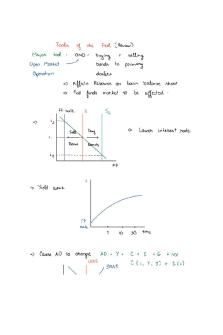Answers Inflation and Monetary policy PDF

| Title | Answers Inflation and Monetary policy |
|---|---|
| Course | Introduction to Economics |
| Institution | Cardiff University |
| Pages | 3 |
| File Size | 107 KB |
| File Type | |
| Total Downloads | 73 |
| Total Views | 210 |
Summary
Questions available ...
Description
UNIT 14. INFLATION AND MONETARY POLICY ANSWER: T14.1 Inflation and deflation Which of the following statements is correct regarding inflation and deflation? Select one answer a. Borrowers benefit from deflation as the value of their debt decreases in real terms. b. Inflation transfers wealth from lenders to borrowers. c. Falling prices benefit consumers and are therefore always good for the economy. d. Inflation makes it difficult for consumers and firms to attain the message about scarcity of resources (sent by relative prices) and is therefore always bad for the economy. Feedback a. Deflation increases the real value of nominal debts. This is undesirable for borrowers. c. Falling prices certainly benefit consumers who have constant nominal income. However if they postpone consumption in expectation of further price falls (particularly of durable goods such as cars) then this leads to a fall in aggregate demand for the economy, which could lead to more deflation. d. It is true that in cases of high and volatile inflation it is hard to separate relative prices changes from the noise of erratically rising prices. However, under mild inflation adjustments in economic activities can take place without losers experiencing falling nominal wages, which is beneficial to the economy (“greasing the wheels of the labour market”).
ANSWER: T14.2 The exchange rate channel of monetary policy Consider a scenario where the Bank of England views the UK economy to be overheating and is attempting to slow the economy down using monetary policy. Which of the following statements is correct regarding the effects of an interest rate rise? Select one answer a. It leads to higher bond prices, which result in higher demand for UK bonds. b. It leads to higher demand for GBP, which results in an appreciation of GBP. c. It leads to the UK exports becoming cheaper and imports becoming more expensive. d. It has opposing effects to the UK’s aggregate demand (AD) of discouraging investment, which lowers AD, and cheaper imports, which boosts AD. Feedback a. An interest rate rise does lead to higher demand for UK bonds, but due to their lower prices. c. Higher interest rate leads to lower bond prices, resulting in higher demand for UK bonds. This in turn leads to GBP appreciation, making UK imports cheaper and exports more expensive, which depresses aggregate demand in the UK. d. Cheaper imports mean higher leakage. This reduces aggregate demand.
ANSWER: T14.3 Inflation-targeting policy The diagram depicts the Phillips curve and the indifference curves of an economy. This economy has an independent central bank with an inflation target of 2%. Based on this information, which of the following statements is correct?
Select one answer a. The central bank will try to achieve zero unemployment while keeping the inflation at 2%. b. The shape of the indifference curves indicates that the central bank is willing to trade higher inflation with lower unemployment at all times. c. Consider an aggregate demand shock that increases unemployment. Without monetary or fiscal policy to counter the negative bargaining gap, the Phillips curve would shift down. d. Consider an aggregate demand shock that increases unemployment. The central bank would raise the interest rate to put downward pressure on inflation, in order to bring it back to the target rate. Feedback a. The Phillips curve means that this is not achievable. The inflation-stabilising unemployment rate is shown to be 6%: this is the outcome of the wage and profit curves. b. This is true in the upward-sloping parts of the indifference curves. Where the indifference curves are downward-sloping (e.g. when unemployment is higher than 6% and the inflation is lower than 2%), the trade-off is between higher unemployment and higher inflation. d. For an aggregate demand shock that increases unemployment, inflation will fall below the target along the Phillips curve. Therefore the central bank should lower interest rate to put upward pressure on inflation, in order to bring it back up to the target rate....
Similar Free PDFs

Inflation-Monetary targeting
- 2 Pages

Chapter 16 Monetary Policy
- 3 Pages

Chapter-5 - Monetary policy
- 11 Pages

A) Monetary policy - pdf
- 4 Pages

ECON CH 13 Monetary Policy
- 8 Pages

Monetary Policy - Lecture notes 1
- 11 Pages
Popular Institutions
- Tinajero National High School - Annex
- Politeknik Caltex Riau
- Yokohama City University
- SGT University
- University of Al-Qadisiyah
- Divine Word College of Vigan
- Techniek College Rotterdam
- Universidade de Santiago
- Universiti Teknologi MARA Cawangan Johor Kampus Pasir Gudang
- Poltekkes Kemenkes Yogyakarta
- Baguio City National High School
- Colegio san marcos
- preparatoria uno
- Centro de Bachillerato Tecnológico Industrial y de Servicios No. 107
- Dalian Maritime University
- Quang Trung Secondary School
- Colegio Tecnológico en Informática
- Corporación Regional de Educación Superior
- Grupo CEDVA
- Dar Al Uloom University
- Centro de Estudios Preuniversitarios de la Universidad Nacional de Ingeniería
- 上智大学
- Aakash International School, Nuna Majara
- San Felipe Neri Catholic School
- Kang Chiao International School - New Taipei City
- Misamis Occidental National High School
- Institución Educativa Escuela Normal Juan Ladrilleros
- Kolehiyo ng Pantukan
- Batanes State College
- Instituto Continental
- Sekolah Menengah Kejuruan Kesehatan Kaltara (Tarakan)
- Colegio de La Inmaculada Concepcion - Cebu









